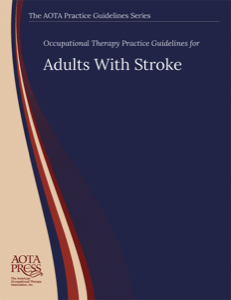Abstract
Every year in the United States, approximately 795,000 people have a stroke; about 610,000 of these events are first-time occurrences. Advancements in medical care related to stroke have greatly improved in recent years, and the annual stroke death rate has declined 35.8% since 2010. This decrease has led to a dramatic increase in the prevalence of people living with chronic symptoms from stroke, which is now a leading cause of disability and one of the most common health conditions treated by occupational therapists. This Practice Guideline provides an overview of the occupational therapy process for adults who have experienced a stroke, defining the domain and interventions that occur within acceptable occupational therapy practice. Topics include evaluation, intervention, and outcomes, and extensive attention is given to cognitive, motor, and psychosocial impairments.
Details
Table of Contents
Occupational Therapy Practice Guidelines for Adults With Stroke
-
Front Matter
11

-
Introduction
118

- Overview of Stroke 724
- Occupational Therapy Process for Adults With Stroke 926
- Best Practice and Summaries of Evidence 3754
- Implications of the Evidence for Occupational Therapy Practice, Education, and Research 6178
-
Appendix A. Preparation and Qualifications of Occupational Therapists and Occupational Therapy Assistants
6784

-
Appendix B. Selected ICD–9 Codes
6986

-
Appendix C. Selected CPT™ Codes for Occupational Therapy Evaluations and Interventions for Adults With Stroke
7188

-
Appendix D. Evidence-Based Practice
7592

-
Appendix E. Evidence Tables
7996

-
References
221238

-
Indexes
241258

